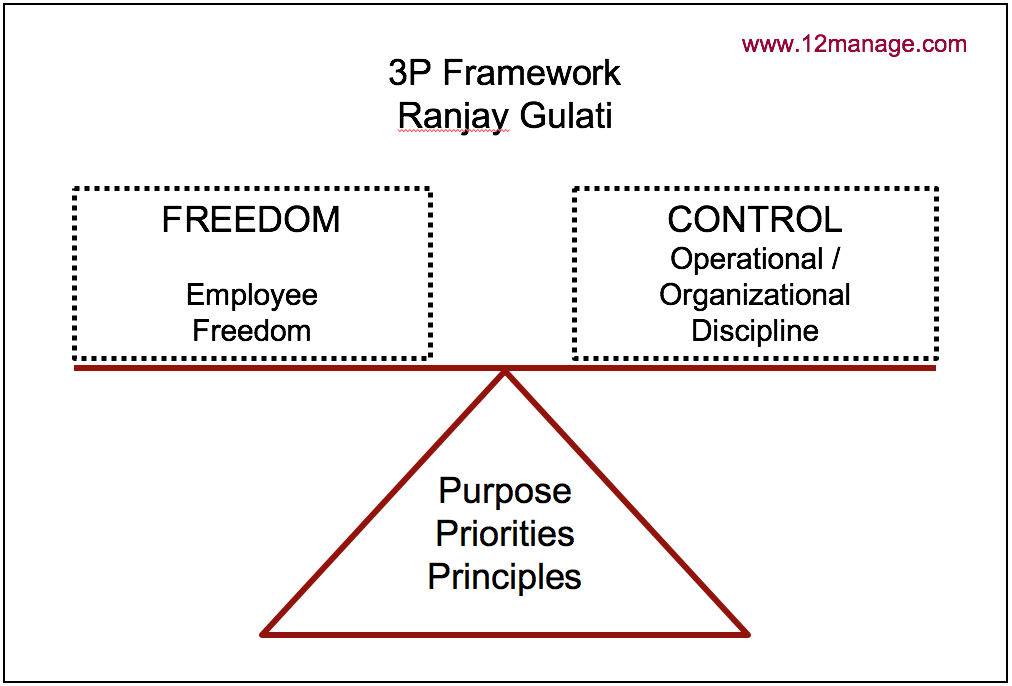

|
Jaap de Jonge
Editor, Netherlands
|
How to Combine Employee Empowerment with Operational Discipline? Gulati's 3P Framework
🔥 According to Professor Ranjay Gulati, executives and managers have trouble resolving the tension between employee empowerment (FREEDOM) and operational discipline (CONTROL). Freedom refers to trusting employees to think and act independently in behalf of the organization. Such freedom is known to increase organizational commitment, improve organizational performance, and to be conducive to innovation. However, unlimited freedom and/or zero control might be inefficient and impractical.
That's why Gulati suggests a "refinement" of earlier work of Bartlett and Ghoshal, who suggested a model built on an engaging corporate purpose, flexible management processes and an employee development policy. In order to resolve the tension between employee empowerment and operational discipline in a more practical and user-friendly way, he suggests a 3P Framework:

- PURPOSE - A single shared goal that sums up the "why" of the organization. It provides direction and meaning to everything the company and its employees do. See also How to Change Towards a Higher Organizational Purpose.
- PRIORITIES - Behavioral rules that reflect the organization's goals. The company's strategic interests, enabling employees to act accordingly and focus their time and company's resources properly. See also CSFs and KPIs and MBO.
- PRINCIPLES - A simple set of principles growing out the organization's purpose and priorities, and helping employees to choose among reasonable options in their day-to-day work. The principles may include positive guidelines for action as well as limits on certain behavior. It is important that the principles are neither defined too precise (that would prevent employee empowerment), nor should they be formulated so broad that they provide no useful guidance.
The author stresses the importance of periodic reviewing and tweaking the framework components (purpose, priorities and principles) using employee and managerial feedback. This connects it to practice and legitimizes it in the eyes of employees.
Drawback of the framework is it's fragility due to its vulnerability to dissolution and it's tendency - if unattended - to revert to bureaucracy. This should be prevented by conscious maintenance and by spending a lot of energy to keep the 3P's in the focus of both management and the employees, continually redefining, evolving and aligning them with the company's changing needs.
Sources:
Ranjay Gulati: "Structure that's not Stifling: How to Give your People Essential Direction - Without Shutting them Down" HBR May-June 2018, pp. 70-79
Christopher A. Bartlett and Sumantra Ghoshal, "Changing the Role of Top Management: Beyond Systems to People", HBR May-June 1995.
X
Sign up for free
Welcome to the Leadership Continuum forum of 12manage.
Here we exchange knowledge and experiences in the field of Leadership Continuum.
❗Sign up now to gain access to 12manage. Completely free.
X
Continue for free
Please sign up and login to continue reading.
Here we exchange knowledge and experiences in the field of Leadership Continuum.
❗Sign up now to gain access to 12manage. Completely free.
| |
|
|
| |


|
Joao Paulo Feijoo
Portugal
|
|
3 Ps and Ambidextrous Organization This framework fits neatly to the concept of organizational ambidexterity, with the 'freedom' side corresponding to the 'agile' components, the 'control' with the efficient ones, and the 'PPP' pivot delivering the required balance and compromise between the former two.
For further reference: Wikipedia and HBR.
|
| |


|
Henry Velasquez
Manager, Colombia
|
|
Empowerment versus Discipline Discipline and empowerment have been two important points to contrast in several studies. But the reality is: empowerment is not successful without discipline (more exactly SELF-discipline). Gulati's final 3 Ps can be helpful to build that pad to achieve the best results for the organization and for the team members' development and growth.
|
| |


|
Bernhard Keim
Business Consultant, Germany
|
|
Too Simple Approach Replace Freedom by Creativity and Control by Coordination and you get a better framework for a viable organisation.
In our times the boundaries of organisations become more and more transparent, kind of blurry. Traditional authoritarian ways to manage a company only worked because the people on top were able to enforce certain types of behaviour.
Beyond the boundaries of an organisation these measures hardly work. There the question for mutual benefits prevails and must be answered on a daily basis, because it his very hard to force our partners to act the way we want them to act.
Therefore communication with partners is king. It helps to gain a better understanding why we act and have to act together. Inside an organisation this mutual respect, open mindedness, communication is often missing and causes troubles that managers try to overcome by ordered discipline, aka bureaucracy. But the meaning of bureaucracy is primarily bureaucracy, not change.
|
| |


|
Alan
Student (University), China
|
|
Innate Ability and Outside Control Freedom and control are both important to motivate employees and run a company.
In my opinion, freedom is more like an innate ability that has both good and bad influences on an operating enterprise. Discipline is something that limits the freedom to take advantage of freedom. So I think 3P method can be illustrated in this way: Purpose, priorities, principles make it more effective to apply operational discipline.
|
| |


|
Jaap de Jonge
Editor, Netherlands
|
|
Struggling with Empowerment vs. Control I guess we can all see organizations with lots of “white collar” workers, both for profit and non-profit, struggling with this tension between:
- The new need for high levels of EMPOWERMENT for knowledge workers and innovators, enabling them to respond to quick changes in demands from customers, to diminishing boundaries of @Bernhard Keim, to fierce competition, etc., and
- The traditional perceived necessity to keep some level of CONTROL over these same employees.
It seems clear that for knowledge workers and innovators, a traditional management-control philosophy does not work well and is often counterproductive.
Some people argue there is no need to control or manage knowledge workers at all. I think that is for most organizations clearly "a bridge too far". For those orgs, the process which Gulati suggests of defining and periodically reviewing and tweaking the mentioned 3 Ps (using employee and managerial feedback) is one helpful tool to guide such employees towards desired behavior, actions and results in a modern and nice way.
|
| |


|
Dr. Remenyi
Coach, Austria
|
|
Redefine Control In my work as a consultant the companies I consulted have found it necessary to redefine the usual concepts of control and trust. So far, control has allways been an instrument that implied a certain ...
|
| |

|
Kappagomtula CL, Malaysia
|
|
Gulati's 3P Model Requires Good Organizational Ethos Ranjay Gulati's 3P model success depends upon the fineness with which the fulcrum (Ed:~ center) of the balance is designed. Employee empowerment comes into play in organizations that have employees wi...
|
| |


|
Jayaram
Business Consultant, India
|
|
Aspects of Balance Freedom <> Control Most organisations seem to have missed the balance of Gulati.
My experience is that most of the time the ego of superior defeats the empowerment to an employee (or 'subordinate"). There are several m...
|
| |


|
Patric Siesing
Consultant, Sweden
|
|
Focus on the Freedom and Control that is Needed I think that what is needed should guide the solution:
What is the control about? What is really needed? Not what is wanted.
Same approach to freedom. What is the freedom about. What is needed...
|
| |


|
Armando Aramayo
Business Consultant, Peru
|
|
Empowerment Must Emphasize Discipline If the rules are clear and everyone knows that they must be followed, empowering certain people is an extraordinary element for competitiveness. That power must be clearly defined but, at the same tim...
|
| |


|
Fredrick Odenge
Turnaround Manager, Kenya
|
|
Employee Empowerment versus Operational Discipline It is a wonderful thing to empower employees in any organization. This gives them freedom to execute their mandate. However, empowerment of employees calls for discipline (operational) on the part of ...
|
| |


|
Bernhard Keim
Business Consultant, Germany
|
|
Follow the Golden Rules @Fredrick Odenge: Follow the 1st Golden Rule: "Treat others at least as good as you want to be treated by them". And the 2nd quite simple rule to stick to is: "Don't do evil".
Funny enough, many peo...
|
| |


|
Patric Siesing
Consultant, Sweden
|
|
Cultural Biases in Empowerment versus Discipline Well, it also depends on the culture. My point of departure is Swedish. Where it is not easy to fire people and where the unions have leverage. It is also very much less hierachical. Management are se...
|
| |


|
Josephat Olwal Ngesah
Kenya
|
|
Empowerment versus Control for Millennials What you all have said is true. Our organizations are-not straight jackets (ed: ~restraining clothing for people who may cause harm to themselves or others). However, we are now living in interesting ...
|
| |


|
Maurice Hogarth
Consultant, United Kingdom
|
|
Employee Empowerment Against Unwanted Anarchy In order to balance wanted empowerment against unwanted anarchy, the essence would seem to be:
KNOWLEDGE; An understanding and acceptance of:
Organisational requirements: business plan target...
|
| |


|
Sarkis Yaralian
Director, Saudi Arabia
|
|
Ceiling, Criticality and Principles In order to keep a balance between empowerment and control, I humbly suggest to replace the 3Ps framework with a 2C and 1P framework. Whereby, The 2 C s would be,
1. A CEILING: maintaining of some ce...
|
| |


|
David Redpath
CEO, Canada
|
|
Sage Advice on Empowerment This is a fascinating discussion and I like the model presented. I am reminded of some advice given to me ages ago by an old Quartermaster in my Regiment "If you trust your lads they will let you down...
|
| |


|
Oshun, Grace Okaima
Lecturer, Nigeria
|
|
Gulati's 3P-framework is Akin to MBO The thought that came to my mind as I read the piece was, how is this different from Management By Objectives (MBO), which I believe serves the same purpose....
|
| |


|
Jaap de Jonge
Editor, Netherlands
|
|
Freedom versus Control is a Central Tension in Managing @Oshun, Grace Okaima: Yes, the necessity to "establish a balance" or "resolve the tension" between Freedom and Control is a central theme when you're managing other people.
So there are many manageme...
|
| |


|
jorge anibal hoyos hoyos
Manager, Colombia
|
|
Responsibilities for Results Empowerment means responsibilities for making decisions with no consulting options but following certain guidelines (the general strategy of the company, the value creation principle amongst others) a...
|
| |


|
Maurice Hogarth
Consultant, United Kingdom
|
|
The 3 Ps in Action Through the 5 Needs of Employees It may be argued that the need for 'control' arose from early manufacturing situations, because the worker's primary need was for survival in the face of overwhelming negative autocratic and slavery c...
|
| |


|
Maurice Hogarth
Consultant, United Kingdom
|
|
Degrees/Levels of Authority for Empowerment @jorge anibal hoyos hoyos: Partly agree but would amend your thought to align with the levels of authority that can be assigned to tasks-responsibilities in an individual's job description (which will...
|
|
|
|
|
More on Leadership Continuum
|
|
|




Comments by date▼